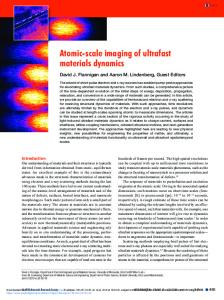Concepts for simulating and understanding materials at the atomic scale
- PDF / 684,755 Bytes
- 8 Pages / 585 x 783 pts Page_size
- 37 Downloads / 361 Views
Introduction The simulation of materials at the atomic scale is almost as old as the first computer and predates even the use of punched paper tape or decks of cards from the early computing experience. Motivated by the need to understand irradiation damage, the computer simulation of atomic processes in matter started growing in the 1950s,1 and it continues to grow. While the last MRS Spring Meeting bore witness to a renewed interest in nuclear materials and irradiation damage (e.g., Symposia U,2 RR,3 and XX4), the power and scope of atomistic simulation in materials science has widened enormously. It now embraces fracture, phase changes, statistical thermodynamics, the evolution of microstructure from point defects to dislocations, biological membranes, and organic/inorganic interfaces. In the field of atomistic simulation, we strive to gain insight into the behavior of real materials under the constraints of contemporary computing power. In the 1930s, Coulson demonstrated how quantum mechanics give rise to interatomic forces in molecules,5 laying some of the foundations for what we now know as tight-binding models. Nevertheless, in the early days of computer simulation, very crude models of interactions between atoms were used for computational simplicity, in which the total energy was described as a sum of pairwise potentials, V:
E tot = 12 ¦V ( Rij ), i, j
(1)
where Rij denotes the distance between the nuclei at positions labeled i and j. It was not until the 1960s that computer power, and concepts in solids, had advanced enough for quantum theory to be put into practice for interatomic forces in condensed matter.6 This led to some of the successful developments in the modeling of interatomic forces with many-body potentials, described here. Several trends and branches can be discerned in modeling interatomic forces today. A central pillar of the field remains the Hohenberg-Kohn-Sham density functional theory7,8 (DFT) using a local density or density gradient, usually referred to as a “generalized gradient,” approximation (LDA or GGA) to quantify the energy of exchange and correlation between electrons. The idea of the LDA is that the electrostatic energy of a sea of electrons is less than the electrostatic energy of a classical continuum of charge because the electrons keep out of each other’s way. Nevertheless, the difference in energy per electron is assumed to be the same at each point in the varying density as it would be if the electrons there were part of a uniform density. The electrostatic energy of electrons as a function of a uniform density has been calculated to good accuracy, and with the LDA, its functional form is used directly for the inhomogeneous density. The GGA is a refinement that makes the energy also a functional of the density gradient at a point. With the computational resources available to most laboratories, DFT provides an acceptable accuracy of energies and structures over the widest range of materials. It is often referred to as an
M.W. Finnis, Department of Materials and Departm
Data Loading...











